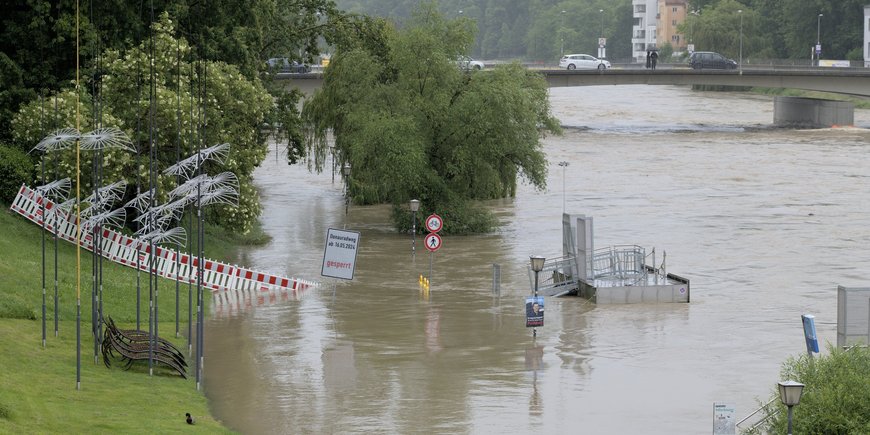Q&A from experts at the the Helmholtz Centre for Environmental Research (UFZ) / Helmholtz Research Field Earth and Environment and at the Helmholtz Centre Potsdam – German Research Centre for Geosciences (GFZ)
1. How did this extreme flood situation come about and what is unusual about it?
The floods in southern Germany over the last few days were triggered by the large amounts of rain caused by the Vb weather situation. A Vb cyclone moves northwards from the Mediterranean and enriches hot air from the Sahara with a lot of moisture over the Mediterranean. Although Vb cyclones are rare (only 5% of all Central European cyclones can be categorised as this track type), they often cause large-scale precipitation extremes in Central Europe. For example, the Vb weather pattern has already been responsible for two major Elbe floods in 2002 and 2013 in the eastern part of Germany in recent decades (Schröter et al., 2015, Tarasova et al., 2020).
This resulted in widespread precipitation totals of 100 to 200 l/m² in 4 days, and locally around 300 l/m² on the edge of the Alps. To put this into context: In the precipitation centres, the precipitation amounts corresponded to an event that statistically occurs less than once every hundred years; in some cases, twice the monthly total fell within a few days.
In addition, last autumn (2023) and spring (2024) were very wet, which meant that the soil was often saturated (www.ufz.de/duerremonitor). When the soil is very moist, it can no longer absorb additional precipitation. While over 90 % of the rainfall is usually initially stored in the soil when the soil is normally moist (Tarasova et al., 2018 a, b) and only flows slowly into the streams and rivers, the runoff volume can increase sharply when the soil moisture is high and large amounts of precipitation fall. As a result, the majority of the precipitation suddenly runs off immediately and can lead to flooding. The combination of high amounts of precipitation from the Vb weather conditions and already moist soils thus caused very high flood discharges in many places in southern Germany in the last few days. Individual peak discharges were far above the previously measured events or the HQ100 discharges, i.e. they occur statistically less frequently than once in 100 years. These high flood discharges and several dam breaches led to severe flooding.
Publications
Schröter, K., Kunz, M., Elmer, F., Mühr, B., & Merz, B. (2015): What made the June 2013 flood in Germany an exceptional event? A hydro-meteorological evaluation. Hydrology and Earth System Sciences, 19(1), 309–327. doi: 10.5194/hess-19-309-2015
Tarasova, L., Basso, S., Zink, M., Merz, R. (2018a): Exploring controls on rainfall‐runoff events: 1. Time series‐based event separation and temporal dynamics of event runoff response in Germany, Water Resour. Res. 54 (10), 7711 – 7732. https://doi.org/10.1029/2018WR022587
Tarasova, L., Basso, S., Poncelet, C., Merz, R. (2018b): Exploring controls on rainfall‐runoff events: 2. Regional patterns and spatial controls of event characteristics in Germany, Water Resour. Res. 54 (10), 7688 – 7710. https://doi.org/10.1029/2018WR022588
Tarasova, L., Basso, S., Wendi, D., Viglione, A., Kumar, R., Merz, R. (2020): A process‐based framework to characterize and classify runoff events – the event typology of Germany, Water Resour. Res. 56 (5), https://doi.org/10.1029/2019WR026951
2. What distinguishes the current flood in southern Germany (and neighbouring areas) from the flood at the turn of the year 2023/24?
Different combinations of precipitation amounts or intensities, the water absorption capacity of the soil and the topography of the catchment area can lead to flood events that can differ significantly in their spatial extent as well as in the height, duration and dynamics of the flooding (Merz, Tarasova & Basso, 2020). For example, due to the considerable amounts of precipitation in autumn, especially in November 2023, the soils were hardly able to absorb any additional precipitation towards the end of last year. The combination of precipitation and snowmelt around Christmas 2023 then led to considerable discharge volumes in many German rivers and the resulting flood situation. In contrast to the flood situation in southern Germany in the previous weeks in June 2024, however, the intensity of precipitation at the turn of the year 2023/24 was lower, so that no extreme flood discharges occurred in numerous rivers and flood protection was able to prevent extreme damage (https://climxtreme.net/index.php/en/component/content/article/33-news/47-hochwasserlage-dezember-23-januar-24). The damage was nevertheless considerable. In Lower Saxony alone, the repair costs for roads, railway lines and dykes are estimated at 170 million euros.
3. In how far does the current flood differ from the Ahr valley flood?
The flood in southern Germany is not comparable to the Ahr flood in 2021. Although the amount of precipitation within 48 hours during the flood in the Ahr valley was 100 to 150 l/m², locally up to 200 l/m², similar to the flood in southern Germany, the precipitation led to a huge, fast-flowing flood wave in the Ahr valley due to the much smaller centre of gravity and the narrowness of the valley. The rapid onset of the flood, the high flow velocities, the great water depths and the large flooded area were unusually extreme (Apel et al., 2022). The flooding significantly exceeded the official hazard map for the extreme flood scenario available in July 2021 (Vorogushyn et al., 2022). This extreme flood had catastrophic consequences in the Ahr valley with 134 fatalities and caused economic damage of around 20 billion euros (Rhein and Kreibich, 2024). The 2024 flood in southern Germany caused six fatalities and other missing persons and caused a provisionally estimated insured loss of around two billion euros.
Publications
Apel, H., Vorogushyn, S., Merz, B. (2022): Brief communication: Impact forecasting could substantially improve the emergency management of deadly floods: case study July 2021 floods in Germany. NHESS, 22, 9, 3005-3014, https://doi.org/10.5194/nhess-22-3005-2022
Rhein, B., Kreibich, H (2024) Causes for the exceptionally high number of deaths during the 2021 flood in the Ahr valley. Forum for Hydrology and Water Management Issue 45.24, 55-61, https://de.dwa.de/de/publikationen-7094.html
Merz, R., Tarasova, L., and Basso, S. (2020). The flood cooking book: ingredients and regional flavours of floods across Germany. ERL, 15(11), 114024. https://doi.org/10.1088/1748-9326/abb9dd
Vorogushyn, S., Apel, H., Kemter, M., & Thieken, A. H. (2022). Analysis of flood hazard in the Ahr valley considering historical floods. Hydrology And Water Management, 66(5), 244-254. https://doi.org/10.5675/HyWa_2022.5_2
4. What other long-term consequences does flooding have? What role do pollutants play? How can we react to them?
The introduction of faecal germs into flood water - including from small sewage treatment plants - can result in regional problems lasting several weeks to months. In these cases, drinking water contaminated with germs as food must be boiled, as announced in the Lower Schussental water supply area, and/or chlorinated by the drinking water works. A contamination of flooded public playgrounds with germs or pollutants cannot be ruled out, as in Lauffen, where use has been officially prohibited. They should therefore only be used once these areas have been cleared by the local authorities.
Mould infestation of flooded objects, which can also persist over a longer period of time, can have harmful effects on health. If necessary, a protective mask should be worn; skin contact should be avoided (1).
Long-term, localised damage due to the ingress of pollutants is to be expected from leaked heating oil from heating oil tanks / oil burners and has occurred in Nordendorf, among other places. Preventive measures are published on the Internet by the Ministry of the Environment in Saarland (2) and the Bavarian State Office for the Environment (3), among others.
The extent to which other pollutants have leaked locally from vehicles flooded in subways is not known. The wading capacity of cars, SUVs and vans is often overestimated. Water depths of more than 20 cm are hardly passable with an ordinary car.
Underestimated are also flooded allotment houses or cellars, in which pesticides, paints and solvents are often stored. If containers come into contact with water, localised pollution cannot be ruled out. Awareness-raising campaigns, such as the one in SWR Wissen (4), are helpful.
Hygiene rules are an important preventative and safety measure in connection with flood-related pollutant emissions and discharges. For example, the Robert Koch Institute advises: "to protect yourself from contact with water that may be contaminated with pathogens when cleaning houses and flats after flooding by wearing rubber boots, waterproof gloves and water-repellent clothing and to wash your hands carefully with hygienically safe water before preparing and eating food and smoking." (5) These measures also protect against contact with other pollutants.
Other possible flood-related pollutant inputs from mining, agriculture and contaminated industrial and commercial sites are often very regional and so specific that no generalised statements can be made. On the one hand, owners are obliged to report such pollutant discharges. On the other hand, state authorities have knowledge of possible sources of pollution. In the case of suspected cases, necessary investigations are required following the flood event in accordance with the Federal Soil Protection and Contaminated Sites Ordinance, from which remediation measures can be derived if necessary.
Sources:
(1) Frequently asked questions about mould infestation.
https://www.umweltbundesamt.de/themen/gesundheit/umwelteinfluesse-auf-den-menschen/schimmel/haeufige-fragen-bei-schimmelbefall#haufige-fragen-bei-schimmelbefall, retrieved 13.06.2024
(2) Floods and heating oil consumer systems.
https://www.saarland.de/mukmav/DE/portale/wasser/informationen/heizoelverbraucheranlagen/heizoelverbr-hochwasser, retrieved 13.06.2024
(3) Safe heating oil storage in the flood zone.
(4) Floods harbour health risks.
https://www.swr.de/wissen/hochwasser-in-sueddeutschland-gesundheit-risiko-100.html, retrieved 13.06.2024
(5) Infection risks in floodplains in Germany.
https://www.rki.de/DE/Content/InfAZ/U/Ueberschwemmung/Infektionsrisiken.html, retrieved 13/06/2024
5. Is compulsory insurance for natural hazards coming? Does it make sense/is it right?
The numerous flooding events in recent months, the large-scale flooding in December and January 2023/2024, the flooding in Saarland in May 2024 and the flooding in southern Germany are worrying and have once again led to the discussion of compulsory insurance. Hesse's Minister President Boris Rhein, in his capacity as Chairman of the Conference of Minister Presidents, has called on the federal government to introduce compulsory insurance against natural hazards. The compulsory offer proposed by the Ampel is not enough for the Minister Presidents. Calls for compulsory flood insurance have so far been rejected. Even on 20 June 2024, when the Federal Chancellor and the federal states discussed compulsory insurance for damage caused by natural hazards, the federal and state governments were unable to agree on compulsory flood insurance (ZDF, 21 June 2024; Schäden durch Extremwetter: Bund lehnt Pflichtversicherung weiter ab / https://www.zdf.de/nachrichten/politik/deutschland/pflichtversicherung-hochwasser-bund-laender-treffen-100.html).
The 2002 floods in particular triggered a political discussion about compulsory flood insurance, which ultimately failed in 2004, mainly due to the unwillingness to accept a state guarantee for extreme damage (Schwarze & Wagner, 2004). The discussion was resumed after the 2013 floods, but ultimately led to the same result. However, in view of the expected increase in ever more extreme flood events due to climate change (Merz et al. 2021) and the difficulties in coping with unprecedented events (Kreibich et al. 2022), an insurance solution to cover the residual risk is becoming increasingly urgent.
Insurance companies can cover the costs of repairing the damage after a flood. However, they also actively contribute to damage reduction by identifying cost-effective measures in the course of on-site inspections, thus preventing minor and frequent damage from occurring in the first place. This includes, for example, sealing cellar shafts through which water could penetrate.
Publications
Kreibich, H., Loon, A. F. V., Schröter, K., et al. (2022): The challenge of unprecedented floods and droughts in risk management. - Nature, 608, 80-86, https://doi.org/10.1038/s41586-022-04917-5
Merz, B., Blöschl, G., Vorogushyn, S., Dottori, F., Aerts, J. C. J. H., Bates, P., Bertola, M., Kemter, M., Kreibich, H., Lall, U., Macdonald, E. (2021): Causes, impacts and patterns of disastrous river floods. - Nature Reviews Earth & Environment, 2, 592-609, https://doi.org/10.1038/s43017-021-00195-3
Schwarze, R., Wagner, G.G. (2004). In the aftermath of Dresden: New directions in German flood insurance. Geneva Papers on Risk and Insurance-Issues and Practise, 29(2), 154-168.
Commentary by Reimund Schwarze, Franz Sinabell (Der Standard, 10 June 2024) https://www.derstandard.at/story/3000000223235/land-unter-und-wer-zahlt-danach
6. Where has flood protection progressed? Keywords: dyke relocation, retention areas, renaturalisation, flood protection infrastructure and more.
Technical flood protection measures such as the construction of dykes, dams and retention areas date back several decades. Following the 2013 floods in the Elbe and Danube regions, which, like the current floods, were triggered by a Vb cyclone, the Conference of Environment Ministers decided to draw up and implement the National Flood Protection Programme (NHWSP) in order to further strengthen flood protection. The programme comprises a total of 242 individual measures on the Danube, Elbe, Rhine, Oder and Weser, including 33 dyke relocations and 61 managed flood retention areas. The estimated investment volume required is 6.7 billion euros. For example, an additional flood retention volume of 255 million m3 was to be created in the Danube basin (LAWA, 2023). The effectiveness of the planned measures was examined and positively assessed in a comprehensive model-based study conducted by the Federal Institute of Hydrology on behalf of the Federal Environment Agency. However, only 9 measures have been implemented so far (as of November 2022). Most of the measures are in the design, planning, approval or construction phase.
Sources
https://www.umweltbundesamt.de/publikationen/untersuchungen-zur-ermittlung-der-wirkungen-von
https://www.lawa.de/documents/230531-broschuere-10-jahre-nhwsp-barr_1685951529.pdf
LAWA (2023): 10 years of the National Flood Protection Programme (NHWSP). Federal/State Working Group on Water (LAWA).
7. What needs to be improved in terms of protection and prevention measures if such flood events occur more frequently in the future, especially longer-lasting, widespread events like the one we are experiencing now?
Our research results show that floods that affect several catchment areas and river sections at the same time are increasing (Kemter et al., 2020, Fang et al., 2024). The Christmas flood of 2023/2024 was the most extensive flood in over 10 years and ranked 9th in the last 70 years. This increasing extent is due to the change in flood processes, which can be seen in line with current climate changes. Such events pose major challenges for flood protection. Cross-border co-operation is becoming increasingly important - both in the management of flood situations and for coordinated flood protection and prevention measures. For example, it will be necessary to strengthen operational capacities, technical equipment and logistics across the board in order to be able to deal with the consequences of flooding in several municipalities and communities within a short period of time.
Publications and sources
Fang, B., Bevacqua, E., Rakovec, O., and Zscheischler, J. (2024): An increase in the spatial extent of European floods over the last 70 years, EGUsphere [preprint], https://doi.org/10.5194/egusphere-2023-2890
Kemter, M., Merz, B., Marwan, N., Vorogushyn, S., & Blöschl, G. (2020). Joint Trends in Flood Magnitudes and Spatial Extents Across Europe. Geophysical Research Letters, 47(7), e2020GL087464. https://doi.org/10.1029/2020GL087464
https://climxtreme.net/images/climxtreme/general/ClimXtreme_weihnachtshochwasser23.pdf
8. Have such extreme events occurred more frequently in recent years or decades?
A study has analysed changes in flood discharges across Europe over the last few decades. For central Europe and north-west Europe, statistically significant increases were found for the most part, i.e. flood levels have increased over a large area in recent decades. We can also see from the observation data that extreme precipitation is increasing. One study, for example, analysed the number of record precipitation events from thousands of climate stations. It shows that in recent years, the number of record precipitation events, i.e. precipitation that has not yet been measured at these stations, is 30 per cent higher worldwide than would be expected in a world without climate change.
Publications
Blöschl, G., Hall, J., Viglione, A., Perdigão, R. A. P., Parajka, J., Merz, B., . . . Živković, N. (2019). Changing climate both increases and decreases European river floods. Nature, 573(7772), 108-111. doi:10.1038/s41586-019-1495-6
Robinson, A., Lehmann, J., Barriopedro, D., Rahmstorf, S., & Coumou, D. (2021). Increasing heat and rainfall extremes now far outside the historical climate. Npj Climate and Atmospheric Science, 4(1), 3-6. https://doi.org/10.1038/s41612-021-00202-w
9. What role does climate change play in this? Should we expect more frequent or even worse events in the future?
Climate change is altering the probability of the occurrence of extreme weather events and thus of flooding. However, these changes vary regionally and for different types of floods (Kemter et al., 2020; Tarasova et al., 2023). There is a very direct link between climate change and flooding in the case of localised flooding caused by short and heavy rainfall, such as thunderstorms. Global warming is increasing localised heavy rainfall in particular, and we are seeing a trend towards more convective weather conditions in Germany. The effects of climate change on river flooding are less clear. Here it depends on the interaction of heavy precipitation and water content in the catchment area (e.g. in the soil and groundwater). The effects of climate change on snowfall and snowmelt also play a role in mountainous regions. Overall, however, we will find ourselves in a situation more often than before in which the existing protective measures are overloaded.
In this respect, in addition to technical protection measures such as dykes and retention basins, we need to be better prepared for such extreme events. One sensible measure is to improve warning systems and the population's response to extreme situations (Najafi et al., 2024). Only if people are informed and know what to do can they react well in an emergency (Kreibich et al., 2021). Another measure is to subject our critical infrastructure (e.g. energy and water supply, hospitals) and our sensitive infrastructure (e.g. care homes) to stress tests, identify critical points and ensure that damage and outages can be minimised in such cases.
Publications
Husain Najafi, Pallav Kumar Shrestha, Oldrich Rakovec, Heiko Apel, Sergiy Vorogushyn, Rohini Kumar, Stephan Thober, Bruno Merz, and Luis Samaniego: High-Resolution Impact-based Early Warning System for Riverine Flooding. Nature Communications, https://doi.org/10.1038/s41467-024-48065-y
Kreibich, H., Hudson, P., & Merz, B. (2021). Knowing What to Do Substantially Improves the Effectiveness of Flood Early Warning. Bulletin of the American Meteorological Society, 102(7), E1450-E1463. https://doi.org/10.1175/BAMS-D-20-0262.1
Kemter, M., Merz, B., Marwan, N., Vorogushyn, S., & Blöschl, G. (2020). Joint Trends in Flood Magnitudes and Spatial Extents Across Europe. Geophysical Research Letters, 47(7), e2020GL087464. https://doi.org/10.1029/2020GL087464
Tarasova, L., Lun, D., Merz, R., Blöschl, G., Basso, S., Bertola, M., Miniussi, A., Rakovec, O., Samaniego, L., Thober, S., Kumar, R. (2023): Shifts in flood generation processes exacerbate regional flood anomalies in Europe, Commun. Earth Environ. 4, doi:10.1038/s43247-023-00714-8
10. Is the term "flood of the century" still appropriate when such severe events occur more frequently?
From a hydrological point of view, we are not talking about the flood of the century, but about the 100-year flood. This term expresses the fact that we have to reckon with such an event at a particular location on average once every 100 years. However, this does not mean that such an event occurs every 100 years, as extreme floods do not occur regularly. It means that we have a 1 per cent probability of such an event occurring in a given year. Several such events can also occur in a few years.
Another aspect is that the term 100-year flood assumes a constant environment. However, climate change and interventions in our landscapes and rivers are changing the probability of a particular flood occurring. What was a 100-year flood yesterday may be a 20-year event today, for example.
For these reasons, but also for psychological reasons, the term "flood of the century" is problematic. It can easily be interpreted as the worst flood that can happen in a century. And if such a flood of the century has occurred, it sounds as if the next comparably severe event can only happen far in the future. But neither is the case. Even if it is not as easy for citizens to grasp as the term "flood of the century", it would probably be better to work with probabilities. And to communicate that these probabilities can change, especially due to climate change.
11. How well can such flood extremes be predicted regionally?
How well floods can be predicted regionally depends, among other things, on how good the precipitation forecasts are. In the current event, large-scale heavy precipitation combined with thunderstorms occurred. While large-scale weather patterns can be predicted with relative certainty a few days in advance, thunderstorms make accurate forecasting considerably more difficult. Combinations of land rain and thunderstorms therefore cause major problems for warning management (1). According to the DWD, when the first flood warnings were issued in Saxony at the end of May, for example, there were still uncertainties regarding the spatial extent and amount of precipitation (2).
Sources
(1) Flood of the century in southern Germany - a review.
https://www.dwd.de/DE/wetter/thema_des_tages/2024/6/4.html, accessed 14/06/2024
(2) Floods - advance warning for large parts of Saxony. https://www.medienservice.sachsen.de/medien/news/1076076, retrieved 14/06/2024
The experts:
Helmholtz Centre Potsdam – German Research Centre for Geosciences (GFZ)
Helmholtz Centre for Environmental Research (UFZ)
The FAQ of the GFZ from January 2024:
https://www.gfz-potsdam.de/presse/meldungen/detailansicht/fragen-und-antworten-zur-aktuellen-hochwasserlage-in-deutschland
The FAQ of the UFZ from January 2024 and March 2024 (In Focus):
https://www.ufz.de/index.php?de=51222
Contact press offices
GFZ / Communication & Media
presse@gfz-potsdam.de
UFZ / Press and Public Relations
presse@ufz.de
















![[Translate to English:] [Translate to English:] Abror Gafurov von dem Schriftzug "Welcome to Azerbaijan" und den UN und COP Logos](/fileadmin/_processed_/2/5/csm_2024_11_Baku_COP29_Abror_Gafurov_1042faec82.jpeg)


![[Translate to English:] Martin Herold standing in front of the library on the Telegrafenberg](/fileadmin/_processed_/c/d/csm_Martin_Herold_d385ee4dd9.jpeg)
![[Translate to English:] Many people are listening to a presentation in the GFZ lecture hall.](/fileadmin/_processed_/c/a/csm_1_Bild1_hell_b9c0e9f5ed.jpeg)






![[Translate to English:] Both scientists sitting on stools in front of a wall of books in the Telegrafenberg library](/fileadmin/_processed_/6/6/csm_Buiter_Castell_DORA_4_e87cb1ea18.jpeg)
![[Translate to English:] Gruppenbild mit 4 Personen](/fileadmin/_processed_/8/d/csm_20241017_GFZ-Emmerman-Medal-005_web_reinhardtundsommer_21a414fa4a.jpeg)






![[Translate to English:] Ice landscape with five red tents](/fileadmin/_processed_/8/9/csm_Zeltlager_auf_dem_Eis_Urheberin_Jenine_McCutcheon_5ced2d523b.jpeg)


